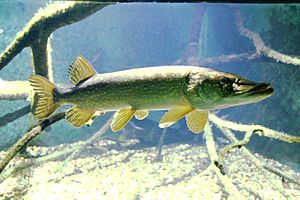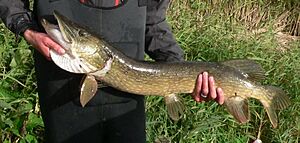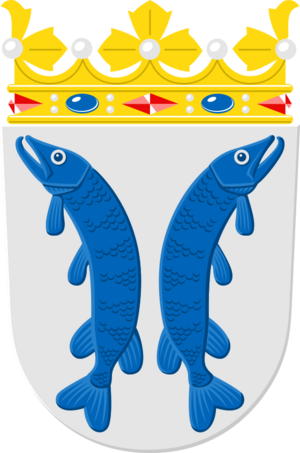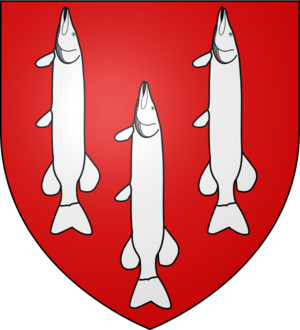Esox facts for kids
Quick facts for kids Esox |
|
|---|---|
 |
|
| Northern pike (E. lucius) | |
| Scientific classification | |
| Kingdom: | |
| Phylum: | |
| Class: | |
| Superorder: | |
| Order: | |
| Family: |
Esocidae
G. Cuvier, 1817
|
| Genus: |
Esox
Linnaeus, 1758
|
| Type species | |
| Esox lucius Linnaeus, 1758
|
|
Esox is a group of fresh water fish. It is the only living group in the family Esocidae. The oldest known Esox fossil is called Esox tiemani. It is about 62 million years old and was found in Alberta, Canada.
Esox fish are often called pike and pickerel. You can find them in the northern parts of North America, Europe, and Asia. One species, Esox lucius, known as the Northern pike, lives in both Europe and North America.
Esox are large predatory fish. This means they hunt and eat other animals. They have long, cylindrical bodies. They are usually green with different shades and have yellow eyes. Pike and pickerel have a forked tail fin and a large, pointed head. Their dorsal (top) and anal fins (bottom) are located far back on their bodies. All species have very sharp teeth.
Contents
Types of Pike: Species
Currently, there are five known species in the Esox family. Scientists are still studying this family. Sometimes, different species naturally create hybrid fish when they breed together.
The five main species are:
- Esox lucius - The Northern Pike; found in both Eurasia and North America.
- Esox reichertii - The Amur pike; found in the Amur river in Asia.
- Esox masquinongy - The Muskellunge; found in northern and eastern North America.
- Esox niger - The Chain pickerel; found in the U.S. states of Georgia and North Carolina.
- Esox americanus - The redfin pickerel; also found in Georgia and North Carolina.
What Pike Eat: Diet

Pike eat many different things. They mostly eat smaller shoal fish, which are fish that swim in groups. Pike can also eat smaller pike, which is called cannibalism. You can see this clearly with the northern pike.
If their usual food is hard to find, pike will also eat insects and amphibians. This includes newts or frogs. Sometimes, they might even catch small mammals like moles or mice if they fall into the water. Small birds like ducklings can also become food for a hungry pike. Pike are also known to eat swimming snakes.
Even though they are good hunters, pike are not usually dangerous to people. There are very few true stories of pike "attacking" humans. Some people who fish or manage fisheries might see pike as a pest. They might unfairly think that pike threaten other native fish or sport fish.
Catching Pike: Angling
Pike are strong fish that fight hard when caught. People use different ways to catch them, like using dead bait, live bait, or special lures. The color of the lure can depend on how clear the water is and the weather.
Pike have many sharp teeth, so you need to be very careful when taking the hook out. It's a good idea to use a wet leather glove and surgical forceps (special pliers) to remove hooks safely.
If you are fishing for fun and plan to let the pike go (called catch and release), taking care of the fish is most important. In the past, some people would hold a pike by its eye sockets. This often hurt the fish's eyes, and they would die later because they couldn't see to hunt.
The best way to hold a pike now is to gently close your hand over its gill covers. You should hold the fish for as short a time as possible before letting it go. For very big pike, holding by the gill covers might not work. Instead, you can put your fingers into the bottom of the gill opening and hold the lower jaw. When holding a big pike, you should also support its belly. Holding a pike this way makes it easier to keep its mouth open to remove the hook.
Some anglers use special grips for the pike's lower jaw. These can make it safer for the angler from the hooks and teeth. However, these grips can sometimes hurt the pike's jaw. The Pike Anglers Club was started in 1977 to help protect pike and the sport of pike fishing.
It's important to set the hook quickly when a pike bites. If the fish swallows the hook too deeply, it can get seriously hurt or die. This is called gut hooking. If a fish is gut hooked, cutting the fishing line right away can still help the fish survive. Placing hooks closer to the back of the bait can help prevent deep hooking.
Some older ways of catching and handling pike are now not allowed. These include the gaff and the gag. A gaff is a metal hook on a pole used to hook the fish's body instead of a net. A gag is a tool that holds the pike's mouth open. These are now illegal in Scotland because they put too much pressure on the pike's jaw and can cause lasting damage.
Pike in Stories: Mythology
In Russian stories, the pike is sometimes seen as a form of evil water spirits called vodyanoy. A very hungry mythical pike is often blamed for eating too many fish in the Sheksna River. But Russian fairy tales also tell about a wise old pike that can grant wishes if someone catches it and then lets it go.
In the Finnish story Kalevala, a hero named Väinämöinen makes a musical instrument called a kantele from the jawbone of a pike.
Pike in Names: Submarines and Tanks
Two United States Navy submarines have been named Pike. These were SS-6 from 1903 and SS-173 from 1935. Three other submarines were named Pickerel: SS-22 from 1912, SS-177 from 1936, and SS-524 from 1944.
Also, the Soviet submarines that NATO calls the Victor III class and Akula class are known as the Shchuka (Щука, meaning "pike") class in Russian. The Soviet Iosif Stalin tank (IS-3) was also nicknamed Shchuka. This was because of its sharply pointed front.
Pike in Symbols: Heraldry
In heraldry, which is the study of coats of arms, the pike is called a lucy in English heraldry or a ged in Scottish heraldry. It is usually shown in certain positions:
- naiant (swimming)
- embowed (bent or bowed)
- hauriant (jumping)
Sometimes, two lucies might appear addorsed (back to back). An example is the coat of arms of the Finnish town of Uusikaupunki. Their arms show "Argent, two lucies addorsed azure," which means two blue pike facing away from each other on a silver background.
Images for kids
-
Quenelle de brochet sauce Nantua (a dish with pike dumplings).
See also
 In Spanish: Lucios para niños
In Spanish: Lucios para niños









